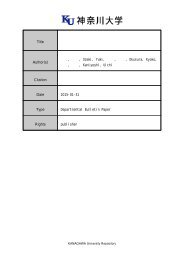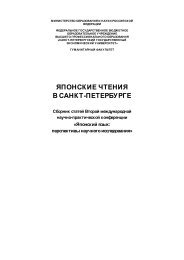to Learners with Special Educational Needs
e-textbook SEN
e-textbook SEN
Create successful ePaper yourself
Turn your PDF publications into a flip-book with our unique Google optimized e-Paper software.
Pokrivčáková, S. et al. (2015). Teaching Foreign Languages <strong>to</strong> <strong>Learners</strong> <strong>with</strong> <strong>Special</strong> <strong>Educational</strong> <strong>Needs</strong>:<br />
e-textbook for foreign language teachers. Nitra: Constantine the Philosopher University. 128 p.<br />
ISBN 978-80-558-0941-0<br />
unsure of themselves. Teachers also mentioned frequently their fear that by adapting teaching<br />
techniques and tempo <strong>to</strong> learners <strong>with</strong> SEN, they would negatively influence and limit progress<br />
of mainstream learners. None of the teachers questioned in 16 theses expressed satisfaction or<br />
feelings of being successful.<br />
Teachers also complained about less-than-ideal cooperation <strong>with</strong> centres of pedagogical<br />
and psychological consultancy and prevention and sometimes very problematic<br />
relationships <strong>with</strong> parents who are not willing <strong>to</strong> accept “otherness” and any special needs of<br />
their children. By comparing their statements <strong>to</strong> the programmes of CPPCPs, it is obvious that<br />
teachers expect very precise, tailor-made directions <strong>with</strong> concrete teaching techniques, while<br />
CPPCPs provide them only <strong>with</strong> general and framework instructions.<br />
Observations described in the theses refer <strong>to</strong> the fact that in practice, integration and<br />
inclusion of learners <strong>with</strong> SEN usually ends behind the classroom´s door. The authors observed<br />
the wide spectrum of incorrect or even harmful teachers´ acts (5):<br />
a) excessively <strong>to</strong>lerant approach where SEN learner do not need <strong>to</strong> do anything because ” they<br />
have disorders”,<br />
b) formally <strong>to</strong>lerant approach where teachers do not apply any special care <strong>to</strong> SEN learners at<br />
the end of the school year while assessing if they improve SEN learners marks;<br />
c) deprecating or doubting approach when teachers are not willing <strong>to</strong> accept SEN learners and<br />
<strong>to</strong> adapt their pedagogical performance so that these needs are fulfilled,<br />
d) incorrect or even harmful re-education, e.g. when teachers ask dysgraphic learners <strong>to</strong> copy<br />
long writing exercise, etc.;<br />
e) inappropriately comparing SEN learners’ outcomes <strong>to</strong> those of mainstream learners;<br />
f) “internal” segregation of SEN learners when they are constantly singled out and appointed<br />
different learning tasks.<br />
It is important <strong>to</strong> emphasize the fact that teachers make these mistakes unintentionally. All of<br />
them expressed their wish and determination <strong>to</strong> help SEN learners. More probably, their<br />
actions resulted from the generally criticised lack of information and proper training. In this<br />
context it is very important that teachers also expressed that they are willing <strong>to</strong> get new<br />
information and undergo specialized teacher training.<br />
Several general teaching tips how <strong>to</strong> help SEN learners<br />
in foreign language classrooms<br />
A. Dyslexia is one of the language-based learning disabilities (<strong>to</strong>gether <strong>with</strong> dysgraphia). It<br />
is a condition in the learner´s brain which causes problems <strong>with</strong> receiving and processing<br />
verbal signs (letters, words, sentences) and, as a result, the learner cannot comprehend the<br />
message easily or correctly. In a more complex explanation, “dyslexia is a specific learning<br />
disability that is neurobiological in origin. It is characterized by difficulties <strong>with</strong> accurate and/or<br />
fluent word recognition and by poor spelling and decoding abilities. These difficulties typically<br />
result from a deficit in the phonological component of language that is often unexpected in<br />
relation <strong>to</strong> other cognitive abilities and the provision of effective classroom instruction.<br />
Secondary consequences may include problems in reading comprehension and reduced reading<br />
experience that can impede growth of vocabulary and background knowledge” (International<br />
Dyslexia Association, n.d.).<br />
Picture 1: The example of dyslectic<br />
perception of a text (taken from Kaplan,<br />
2014).<br />
14






